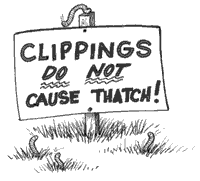Fertilizing With Good Soil
What Is Good Soil?
Good soil has loose texture and contains 3 to 5% organic material, or humus, in the top few inches. It absorbs and holds moisture, yet drains well. Therefore it is able to support lots of earthworms and harbor a massive population of valuable microbes. These organisms generate 50% or more of the nutrient needs of any turfgrass as they process the organic matter through their digestive systems.
If you take the trouble to build and maintain good soil on your property, it will take care of your grass for the most part. Your fertilizing job will be much simpler. Aerate the lawn every couple of years to reduce thatch and combat the normal compaction that develops from foot traffic and the occasional heavy vehicle or construction equipment in some areas. Add organic matter on a regular basis by topdressing the lawn with topsoil, compost, peat moss or chopped leaves from a mulching lawn mower.
Good Soil Saves Time and Fertilizer
Because good soil already contains some nutrients, fertilizer is necessary only as a supplement. Turfgrasses vary somewhat in their nutritional needs, but most experts agree that both northern and southern types need about 4 pounds of nitrogen per 1000 square feet per season to be vigorous and healthy. If you maintain healthy soil, it will provide at least half, maybe two-thirds of that nitrogen. Earthworm castings contribute 1 pound of nitrogen and active soil microbes provide another pound. If you leave the clippings on the turf each time you mow the lawn, they will also contribute one pound of nitrogen over the season. So it is necessary to fertilize only once per year--best done in the fall.
If you are interested in the best possible lawn for the least possible effort, fertilizing is an area where you can save a lot of time and energy. By incorporating practices such as leaving clippings, encouraging earthworms and using granular slow-acting fertilizer, it is possible to build and maintain fertile, nutritious soil that will support vigorous grass plants with only one fertilizing session, rather than three or four.
Add Nutrients by Leaving the Grass Clippings
A mulching lawn mower makes it easy to leave the clippings on the lawn as you mow. Clippings left to decompose on the turf can contribute up to 25% of your lawn's seasonal fertilizer needs over a season. They are a pretty balanced fertilizer in their own right, usually containing approximately 3 to 4% nitrogen, 2% potassium and 1/2 % phosphorus.
A season's worth of clippings represents .5 to 1 pound of nitrogen for every 1000 square feet of your lawn. If you don't leave the clippings you will need to provide that pound of nitrogen with an (additional) application of fertilizer.

Enrich Soil by Attracting Earthworms and Microbes
Encourage Earthworms: While their travels also help loosen and aerate soil, earthworms' greatest contribution to soil health is the production of natural fertilizer as they excrete their weight in castings every day. In a 1000 square foot area, for example, five worms per cubic foot (a low population) generate over 150 pounds--about 1/3 pound per worm--of top-grade fertilizer during each growing season. Earthworm castings offer the equivalent of from .5 to 1 pound of nitrogen per 1000 square feet per year. They contain the key plant nutrients, plus many of the essential micronutrients grass plants need. Even dead earthworms are rich in nitrogen.
Encourage Microbial Soil Life: Aerated soil that contains 3% to 5% organic matter in its top 8 to 12 inches has a very active microbial population. Microbes decompose thatch, control diseases and pest insects, and produce nutrients as they eat, eliminate and reproduce. Working in a soil with sufficient organic matter they will produce .5 to 1 pound of nitrogen per 1000 square feet of lawn each season--about 20% of your lawn's nitrogen needs.
